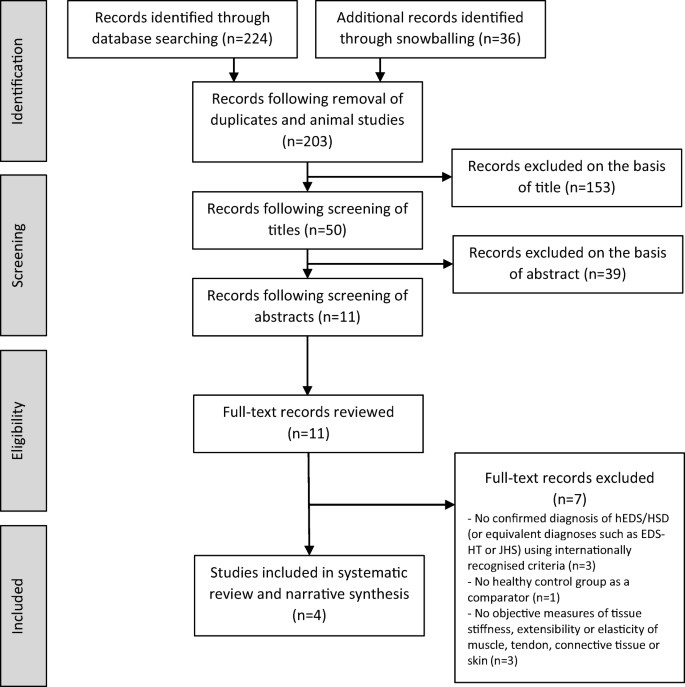Here’s a new article that explores a few ways that might be useful to evaluate a patient’s tissues as part of the hEDS/HSD diagnosis process.
Quantitative measures of tissue mechanics to detect hypermobile Ehlers-Danlos syndrome and hypermobility syndrome disorders: a systematic review (2020)
- Palmer, S., Denner, E., Riglar, M., Scannell, H., Webb, S. and Young, G., Clinical Rheumatology
ABSTRACT

Article Highlights:
- “One of the signs of hEDS/HSD is increased tissue elasticity, and this is believed to have a negative impact on passive and active joint stability [9]. Joint instability may result from ligamentous laxity but also altered force production and transmission through the musculotendinous structures.”
On the Validity of Current Evaluation Methods:
- “Tissue elasticity is traditionally assessed in these conditions using the 9- point Beighton score of joint motion [10]…..However, one might question the validity of the Beighton score as an indicator of a specific connective tissue disorder because”:
- it does not include many commonly affected joints [11],
- does not assess connective tissues more widely”
- and it may be affected by:
- age, sex, ethnicity
- stretching
- “habitual postures and movements”
- hormones such as relaxin, which is increased during menstruation and current/recent pregnancy.
- “Relaxin regulates the remodelling of tissue structures such as bone, synovium, cartilage, ligaments and tendons [27].”
- “Relaxin regulates the remodelling of tissue structures such as bone, synovium, cartilage, ligaments and tendons [27].”
- “The 2017 criteria for hEDS does also include semiquantitative assessment of skin extensibility” on the palm-side of the forearm.
- > 1.5 cm is considered hyperextensible, but “the basis for this cut-off of > 1.5 cm is unclear”
- Studies on skin elasticity have included participants “from 18 to 89 years [old], which is an important factor when measuring the mechanical properties of skin, because of collagen changes with age.”
- For example, people over 40 have been found to have “greater laxity and reduced elasticity in skin”
- And reduced skin elasticity has been linked to “hormonal changes over time, particularly during the menopause.”
- Studies on skin elasticity have included participants “from 18 to 89 years [old], which is an important factor when measuring the mechanical properties of skin, because of collagen changes with age.”
- > 1.5 cm is considered hyperextensible, but “the basis for this cut-off of > 1.5 cm is unclear”
Findings:
- One method of measuring skin extensibility, elasticity and stiffness is the suction cup method, which “Grahame and Beighton [18] used ..to plot stress-strain curves for skin elasticity in EDS patients half a century ago”
- However in this review “there were no differences in skin elasticity between [EDSers and controls] using the SC method.”
- Another method is the soft tissue stiffness meter (STSM)
- In one 2009 study (as it was pre-2017 diagnostic criteria, most people with an EDS-HT diagnosis then would now get an HSD diagnosis) the “STSM found differences in skin consistency on the volar [palm-side] aspect of the forearm.”
- People with EDS-HT “had lower stiffness than controls” but BJHS folks did not.
- No differences were found on the top side of the forearm between the groups.
- In one 2009 study (as it was pre-2017 diagnostic criteria, most people with an EDS-HT diagnosis then would now get an HSD diagnosis) the “STSM found differences in skin consistency on the volar [palm-side] aspect of the forearm.”
- Another study “used strain elastography to examine passive stiffness in the Achilles tendon, patellar tendon and five muscles.”
- The “strain ratio distinguished between groups” at the brachioradialis muscle and patellar tendon, as did the strain index with the addition of the Achilles tendon as well.
- “There was a higher proportion of soft tissues in the biceps brachii and Achilles tendon and a lower proportion of hard tissues in the biceps brachii, brachioradialis and Achilles tendon in people with HSD, when compared to healthy controls.”
- “Of these sites, the Achilles tendon seemed particularly promising as differences were observed using three outcomes—the strain index and the proportion of both soft and hard tissues.”
- However, elastography’s “clinical utility might still be questioned due to the specialist equipment and training required.”
- “These issues highlight the potential for improved objective assessment of tissue mechanics as part of hEDS/HSD diagnosis”
Future Research:
- “The role of relaxin on tissue stiffness in women with hEDS/HSD may therefore be important to consider in future research”
- “Future research should further investigate the potential use of handheld tissue stiffness meters and ultrasound methods to contribute towards the diagnosis of hEDS/HSD.”
- “Additionally, it is recommended that attention is paid to recruiting representative samples in terms of age, gender and ethnicity,” and “future studies should include blinding to avoid investigator bias and should perform prospective study size calculations.”
Citation:
Palmer, S., Denner, E., Riglar, M., Scannell, H., Webb, S. and Young, G., 2020. Quantitative measures of tissue mechanics to detect hypermobile Ehlers-Danlos syndrome and hypermobility syndrome disorders: a systematic review. Clinical Rheumatology, pp.1-11.
